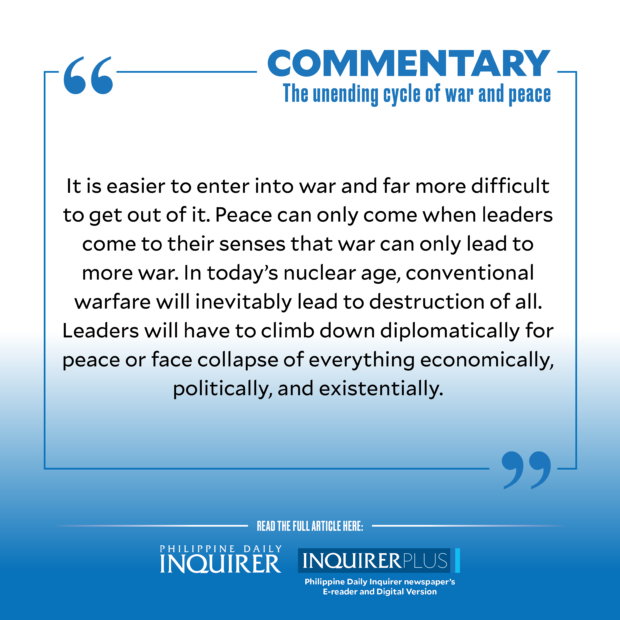Are we moving into an escalating phase toward war?
With armed conflict in Ukraine, coups in Niger and Central Africa, and the hottest July in recorded history, the combination of climate change and war is becoming increasingly volatile. The United States Director of National Intelligence’s 2021 report on Global Trends 2040 paints a bleak picture of the future, stating that the world will face more intense and interconnected challenges such as disease, climate change, technological disruptions, and financial crises. These challenges will push communities, states, and the international system beyond their capacity, leading to increased contestation at all levels.
At the core of global tensions is the West’s refusal to accommodate the interests of the Rest, instead opting for a policy of containment. The recent BRICS summit in New Delhi highlighted the growing divide between the predominantly white wealthy West (excluding Japan) and the Rest. While NATO expands eastwards to the Pacific, BRICS has added six new members: Argentina, Ethiopia, Iran, Egypt, Saudi Arabia, and the United Arab Emirates. Together, BRICS will account for 29% of world GDP and 46.1% of the world population, compared to NATO plus Japan, which accounts for 51.2% of world GDP and 13.6% of the world population. BRICS also possesses 40.8% of the world’s oil and gas reserves, while NATO and the Group of Seven only hold 13.4% and 12.8% respectively. Furthermore, BRICS is more inclusive as it includes countries like Ethiopia, Iran, Egypt, and the UAE that are not part of the G20.
What makes BRICS truly fascinating is that most of its members are former colonies or have historically experienced invasions by NATO members, including Japan. It is worth noting that Japan is discharging its Fukushima radioactive water into the Pacific as a gesture of goodwill towards its neighbors. However, if the water is indeed safe, why don’t they pump it into Japanese soil? Instances like the Fukushima nuclear waste water harming a densely populated world illustrate Austrian professor Friedrich Glasl’s nine-stage conflict escalation model. Glasl observed that conflicts within organizations follow a three-stage pattern with three levels: win-win, win-lose, and lose-lose. In the win-win stage, level one is characterized by tension and the hardening of views, while level two involves debates and disagreements. Level three signifies the shift towards action. In the win-lose stage, both parties strive to form coalitions and seek allies to strengthen their arguments and bargaining positions (level four). Level five brings about actions that cause the other side to lose face. Level six introduces actual strategies and threats, with one side branding the other as an opponent, rival, or enemy. Level seven marks a worsening of the situation as one side believes that its limited action will cause the other side to suffer greater losses, thus inviting retaliation. Level eight involves attacks on each other’s vital functions, leading to fragmentation, surrender, or collapse of the other side. Finally, level nine is the stage of nuclear mutually assured destruction, where everyone loses. According to Glasl’s model, de-escalation is possible if both sides seize opportunities to shift from military action to diplomacy.
The conflict in Ukraine teaches us the crucial lesson of considering the perspective of the other side. Supporters of Ukraine perceive the violation of sovereignty as a principle worth defending at all costs. On the other hand, the Russians argue that they are fighting for the existence of their sovereign state. The movement of NATO westward serves as a reminder to Russia that it has been invaded by Western Europe twice before – by Napoleon and Nazi Germany. As history has shown, wars often have a complex mix of rationality and emotion, with seemingly insignificant incidents like the assassination of Archduke Franz Ferdinand triggering rapid mobilization and war. World War II, for instance, was driven by Nazi Germany seeking revenge for its previous defeat. It is easier to initiate war than to end it. Peace can only be achieved when leaders realize that war will only breed more war. In today’s era of nuclear weapons, conventional warfare inevitably leads to the destruction of all parties involved. Leaders must choose diplomatic de-escalation in pursuit of peace, or else face economic, political, and existential collapse. There can be no victory in nuclear war, and even a return to the status quo is unlikely. Thus, peace remains the only viable option.
Asia News Network —————- Andrew Sheng is the former chair of the Hong Kong Securities and Futures Commission.
The Philippine Daily Inquirer is a member of the Asia News Network, an alliance of 22 media titles in the region.
Your subscription could not be saved. Please try again.
Your subscription has been successful.
Read Next
Don’t miss out on the latest news and information. Subscribe to INQUIRER PLUS to get access to The Philippine Daily Inquirer & other 70+ titles, share up to 5 gadgets, listen to the news, download as early as 4 am & share articles on social media. Call 896 6000. For feedback, complaints, or inquiries, contact us.
Denial of responsibility! Vigour Times is an automatic aggregator of Global media. In each content, the hyperlink to the primary source is specified. All trademarks belong to their rightful owners, and all materials to their authors. For any complaint, please reach us at – [email protected]. We will take necessary action within 24 hours.


